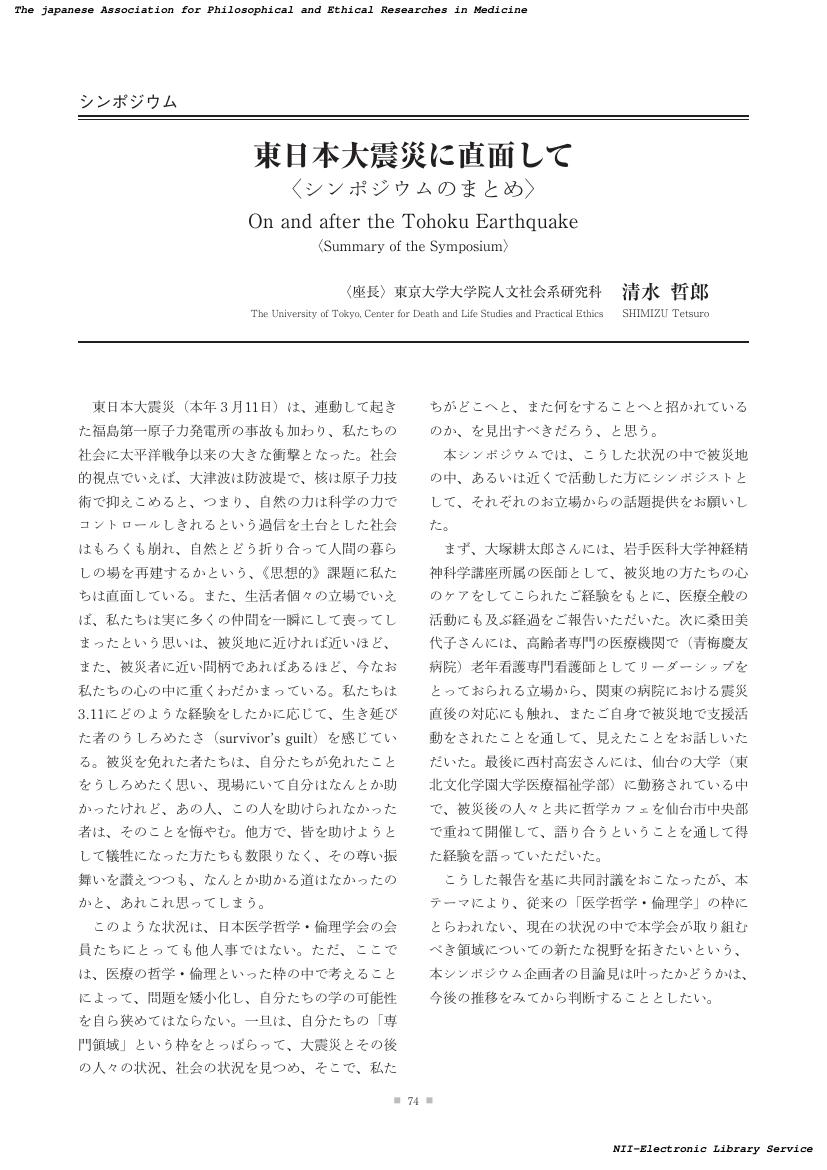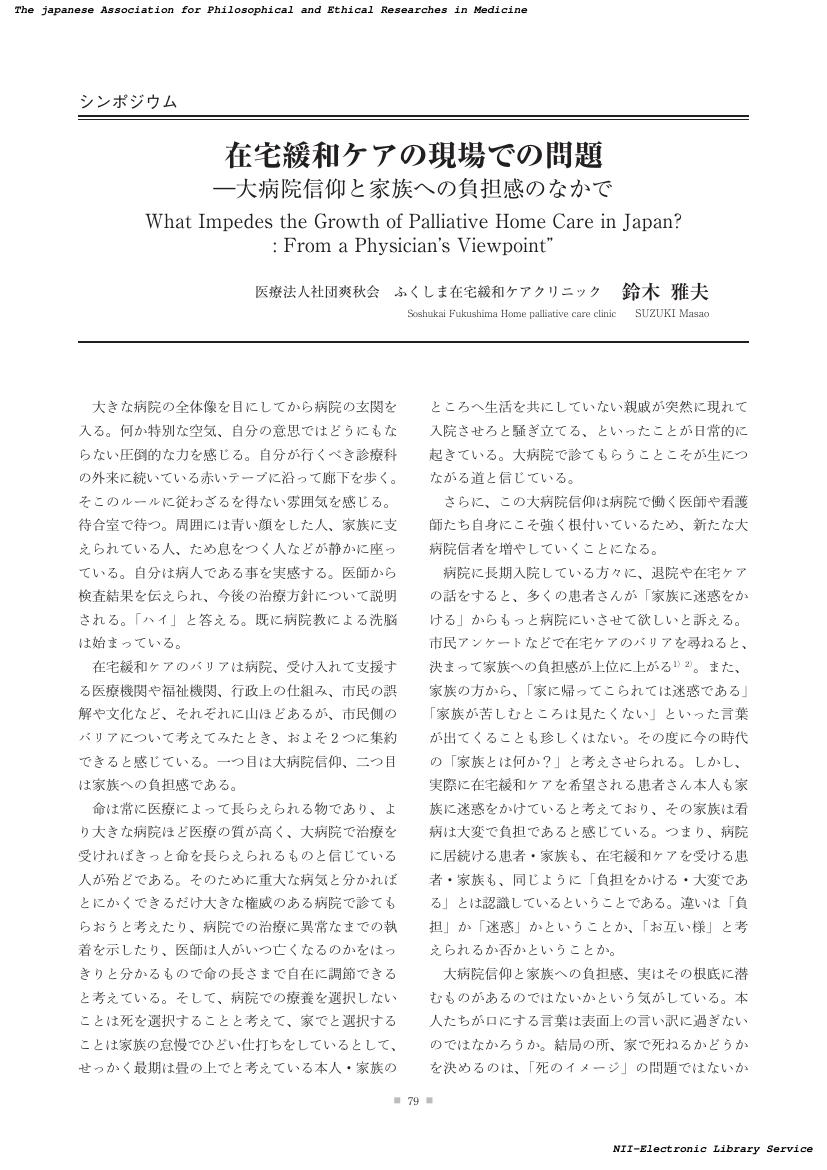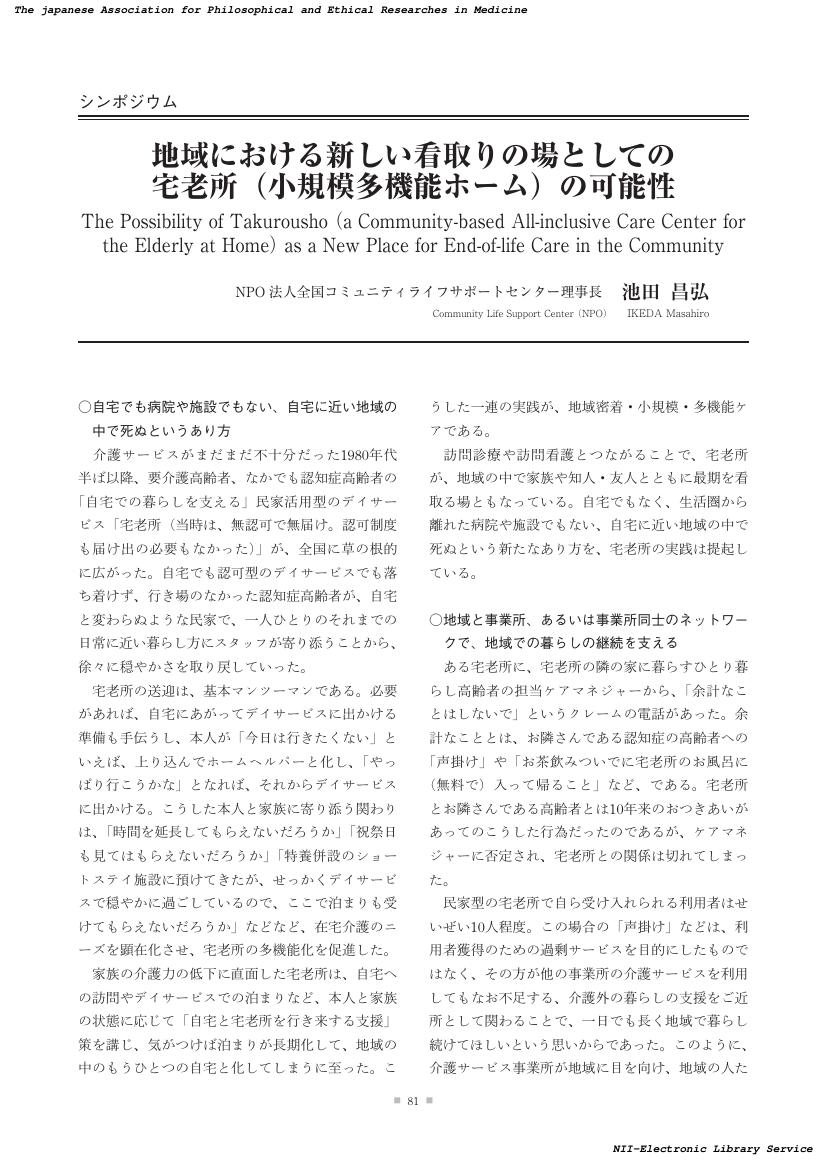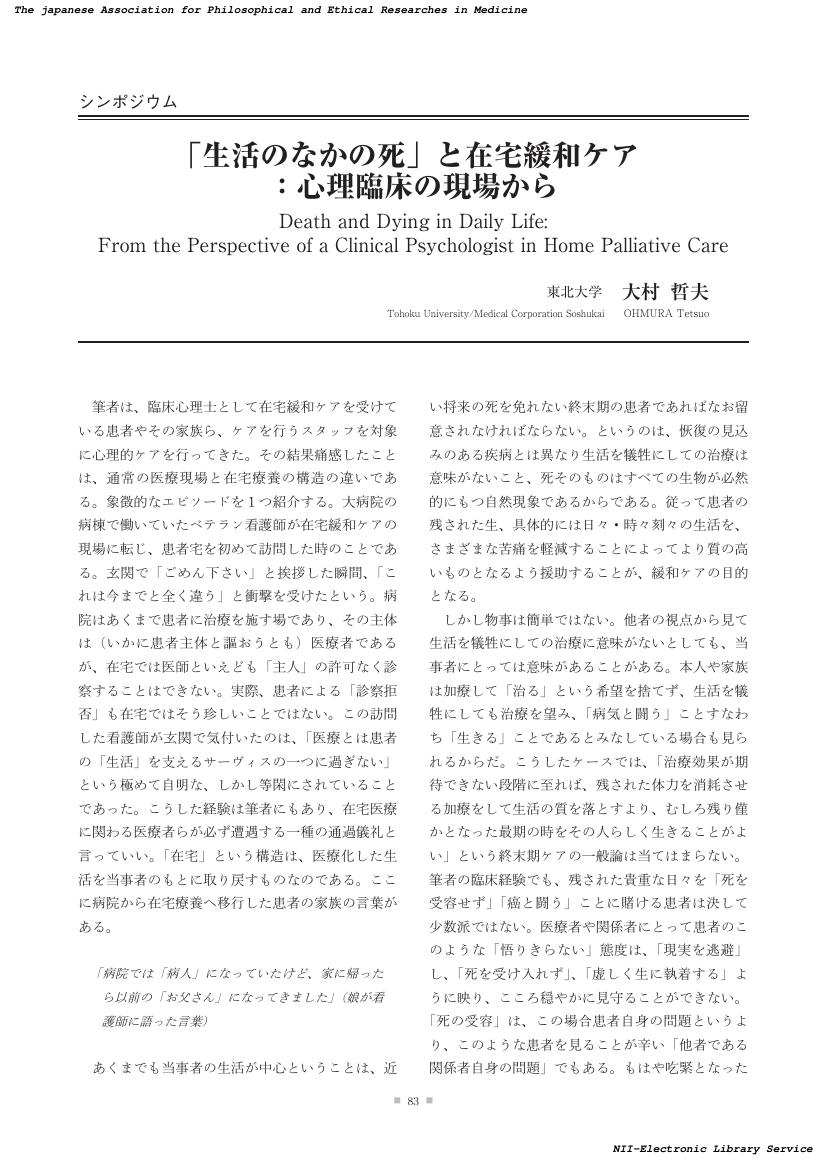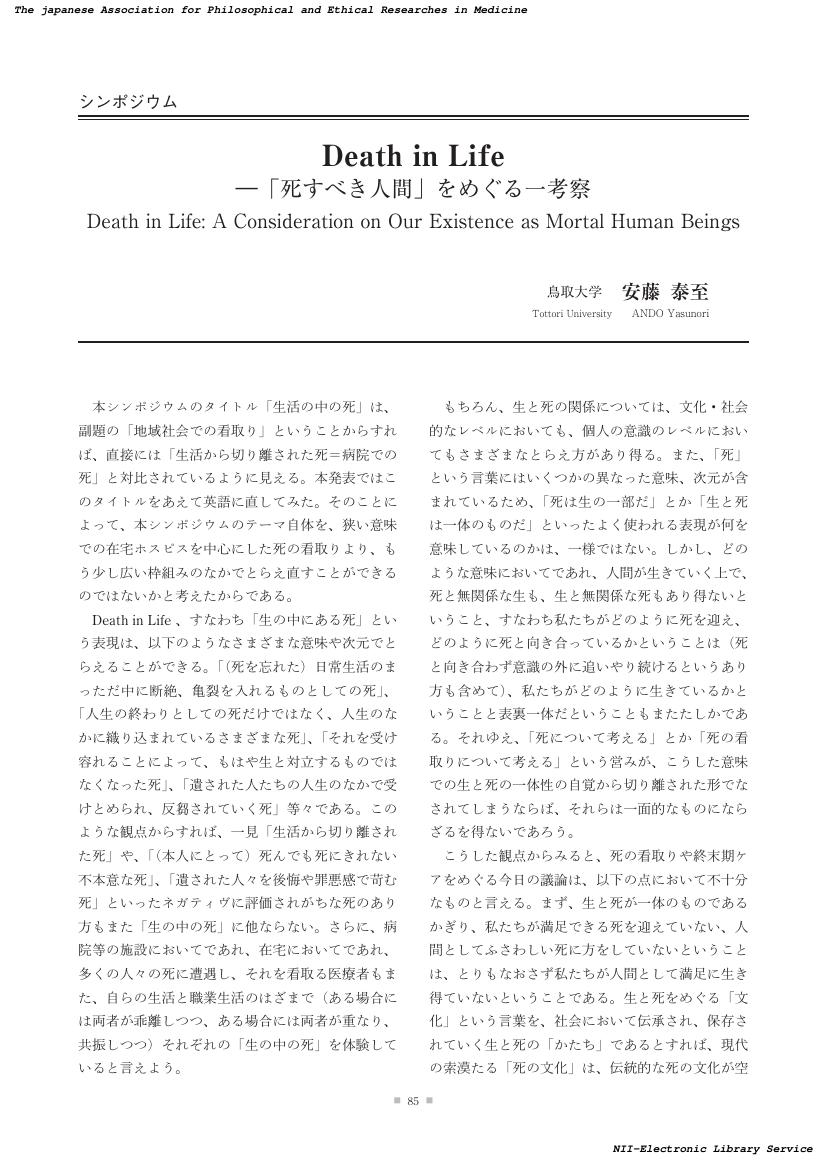- 著者
- 宮坂 道夫
- 出版者
- 日本医学哲学・倫理学会
- 雑誌
- 医学哲学 医学倫理 (ISSN:02896427)
- 巻号頁・発行日
- vol.31, pp.51-54, 2013 (Released:2018-02-01)
1 0 0 0 OA 合意形成の倫理的基礎づけについて
- 著者
- 坪井 雅史
- 出版者
- 日本医学哲学・倫理学会
- 雑誌
- 医学哲学 医学倫理 (ISSN:02896427)
- 巻号頁・発行日
- vol.30, pp.30-39, 2012-09-30 (Released:2018-02-01)
When we discuss medical technology or its application to healthcare, we often refer to "consensus building." However, we rarely hear this term used in the context of discussions concerning ethics. Consensus alone cannot guarantee ethical behavior, however, and so there is a need to consider possible ways of justifying the application of consensus to ethics, as well as to develop a mode of consensus building that is ethically appropriate. At the outset of this study, I introduce prior Japanese scholarship related to this issue, as a means of prefacing my discussion. Next, I suggest that the narrative method can play a positive role in the consensus building process. More specifically, in the context of a discussion of advanced medical technology, I state that "narrative consensus building" plays an important role. This is due to the fact that we are required to evaluate such advanced medical technologies during the long process through which they come to be accepted within societies. The question of whether these technologies should be accepted cannot be answered only through cost-benefit analysis. Therefore, we need to adopt a narrative mode of thought when pursuing a process of consensus building. Finally, I take up the role of bioethicists in the process of consensus building. First, they can be the facilitators of such discussions. Secondly, they can serve as narrators themselves, producing the narratives that make it possible to imagine a future society within which we have adopted advanced medical technologies.
1 0 0 0 OA ヨナス倫理学における「犠牲」について
- 著者
- 山本 剛史
- 出版者
- 日本医学哲学・倫理学会
- 雑誌
- 医学哲学 医学倫理 (ISSN:02896427)
- 巻号頁・発行日
- vol.30, pp.52-62, 2012-09-30 (Released:2018-02-01)
In this article, I show the significance of Hans Jonas' ethics of responsibility in the situation wherein the ethical problems of technology extend from the present to the future generations. Jonas used his consideration of the problem of bioethics of experiments on a human body as his opportunity to begin his study of ethics in earnest. At the same time, he criticizes the re-definition of death as this enables and promotes the practice of organ transplants from an irreversibly comatose donor. Both human body experiments and the re-definition of death are considered from the viewpoint of the defenseless victim who is sacrificed in the name of medical progress to save lives and conquer disease. Jonas insists on the "-descending order of permissibility-" as a general principle to prevent sacrificing the defenseless victim. According to Jonas' philosophy of life, it is not appropriate to understand the human mind and body as separate entities. Life itself is not lost even if it is assumed that consciousness does not recover if the body lives. Extraction of organs from such a person who is incapable of putting up a defense constitutes a sacrifice of the defenseless victim. Jonas positions future generations as the ultimate victim in "the principle of responsibility" and advocates a new ethic to forbid the act that offers them in a one-sided sacrifice. He reforms ethics from a form that assumes the individual and autonomous subject to a form that considers the relationship between the subject and object of the responsibility. Jonas shows that the fundamental human character, that is, two paradigms of the responsible subject, "parent" and "politician" enables one to make a self-sacrifice through one's identification with his/her problem. The ethics of Hans Jonas is imbued with the idea of prevention of sacrifice of the victim.
1 0 0 0 OA 配偶子ドナーの保護と権利について
- 著者
- 遠矢 和希
- 出版者
- 日本医学哲学・倫理学会
- 雑誌
- 医学哲学 医学倫理 (ISSN:02896427)
- 巻号頁・発行日
- vol.30, pp.68-73, 2012-09-30 (Released:2018-02-01)
In Japan, there is little discussion about gamete donation for Assisted Reproductive Technology (ART) amongst the general public. Nevertheless, gamete donors' situations and rights should be considered when the government regulates ART. A report by a committee of the Health, Labour and Welfare Ministry in 2003 made recommendations for the regulation of ART, and also made proposals for the Informed Consent (IC) of gamete donors. A report by The Ethics Committee of the American Society for Reproductive Medicine and a guideline by the New York State Department of Health contribute to the understanding of the protection of donors' autonomy and rights. Through interpreting these documents and other papers, gamete donors' rights of anonymity, remuneration, etc. involve ethical issues concerning the welfare of the resulting children. These rights of gamete donors also affect the relationships among the people concerned including the resulting children. Through discussing the theme of gamete donors' rights and the protection of autonomy in this paper, it became clear that gamete donors should recognize their responsibilities and liabilities in relation to the welfare of the resulting children. The resulting children's welfare should be considered when determining gamete donors' rights and IC in regulating ART and gamete donation in Japan.
1 0 0 0 OA シンポジウムのまとめ(東日本大震災に直面して)
- 著者
- 清水 哲郎
- 出版者
- 日本医学哲学・倫理学会
- 雑誌
- 医学哲学 医学倫理 (ISSN:02896427)
- 巻号頁・発行日
- vol.30, pp.74-75, 2012-09-30 (Released:2018-02-01)
- 著者
- 桑田 美代子
- 出版者
- 日本医学哲学・倫理学会
- 雑誌
- 医学哲学 医学倫理 (ISSN:02896427)
- 巻号頁・発行日
- vol.30, pp.76-80, 2012-09-30 (Released:2018-02-01)
1 0 0 0 OA 震災は哲学を試す? : 被災地での「哲学的実践」の試み(東日本大震災に直面して)
- 著者
- 西村 高宏
- 出版者
- 日本医学哲学・倫理学会
- 雑誌
- 医学哲学 医学倫理 (ISSN:02896427)
- 巻号頁・発行日
- vol.30, pp.81-85, 2012-09-30 (Released:2018-02-01)
1 0 0 0 OA 病原生物との共生への一視座 : 動物の感染症の倫理的問題の検討をつうじて
- 著者
- 安部 彰
- 出版者
- 日本医学哲学・倫理学会
- 雑誌
- 医学哲学 医学倫理 (ISSN:02896427)
- 巻号頁・発行日
- vol.30, pp.1-10, 2012-09-30 (Released:2018-02-01)
This study had two objectives. First, we examined the possibility of animal infectious diseases being caused by humans, clarifying specific links between anthropogenic changes to freshwater ecosystems and the emergence(or spread) of Koi Herpes Virus disease(KHVD). Second, we considered related ethical problems. We concluded that there is no ethical justification for the KHVD case from a utilitarian perspective. Furthermore, we should endeavor to promote precautionary environmental management to decrease the number and spread of animal(and human) infectious diseases.
- 著者
- 有馬 斉
- 出版者
- 日本医学哲学・倫理学会
- 雑誌
- 医学哲学 医学倫理 (ISSN:02896427)
- 巻号頁・発行日
- vol.29, pp.73-76, 2011-09-30 (Released:2018-02-01)
1 0 0 0 OA 生活のなかの死:地域社会での看取りを考える(シンポジウムのまとめ)
- 著者
- 竹之内 裕文 大谷 いづみ
- 出版者
- 日本医学哲学・倫理学会
- 雑誌
- 医学哲学 医学倫理 (ISSN:02896427)
- 巻号頁・発行日
- vol.29, pp.77-78, 2011-09-30 (Released:2018-02-01)
- 著者
- 鈴木 雅夫
- 出版者
- 日本医学哲学・倫理学会
- 雑誌
- 医学哲学 医学倫理 (ISSN:02896427)
- 巻号頁・発行日
- vol.29, pp.79-80, 2011-09-30 (Released:2018-02-01)
- 著者
- 池田 昌弘
- 出版者
- 日本医学哲学・倫理学会
- 雑誌
- 医学哲学 医学倫理 (ISSN:02896427)
- 巻号頁・発行日
- vol.29, pp.81-82, 2011-09-30 (Released:2018-02-01)
- 著者
- 大村 哲夫
- 出版者
- 日本医学哲学・倫理学会
- 雑誌
- 医学哲学 医学倫理 (ISSN:02896427)
- 巻号頁・発行日
- vol.29, pp.83-84, 2011-09-30 (Released:2018-02-01)
- 著者
- 安藤 泰至
- 出版者
- 日本医学哲学・倫理学会
- 雑誌
- 医学哲学 医学倫理 (ISSN:02896427)
- 巻号頁・発行日
- vol.29, pp.85-86, 2011-09-30 (Released:2018-02-01)
1 0 0 0 OA 医の倫理や哲学への一老医の回想
- 著者
- 品川 信良
- 出版者
- 日本医学哲学・倫理学会
- 雑誌
- 医学哲学 医学倫理 (ISSN:02896427)
- 巻号頁・発行日
- vol.29, pp.1-3, 2011-09-30 (Released:2018-02-01)
- 著者
- 大橋 範子
- 出版者
- 日本医学哲学・倫理学会
- 雑誌
- 医学哲学 医学倫理 (ISSN:02896427)
- 巻号頁・発行日
- vol.29, pp.4-14, 2011-09-30 (Released:2018-02-01)
Advances in the field of genetics have enabled the diagnosis of many genetic diseases, which has led to the benefits of prevention, early detection and treatment in some of them. Nevertheless many are neither preventable nor curable yet, even though we can diagnose them. Moreover, discrimination against patients with genetic diseases and their blood relatives exists. Therefore, a person tested who was diagnose with a genetic disease is sometimes determined to keep the test result from not only his/her employer and insurance company, but also his/her relatives (spouse and blood relatives). However, for blood relatives who are at the same genetic risk, knowing the result may be desirable from the viewpoint of prevention, detection, and treatment in the early stage, when the disease is preventable or curable. In this situation, two conflicting rights, namely, the right to privacy of the tested person and the right of blood relatives to know may be asserted. Although health care providers are responsible for the confidentiality of patient information, they may plan to inform blood relatives of their genetic risk for the sake of the above-mentioned benefits. This paper deals with the subject of how the conflict of interest between the tested person and his/her relatives should be regulated, and what actions health care providers should take. Blood relatives and the tested person share some common genetic information. I think that the genetic information of the tested person can be considered as that of blood relatives themselves under specified strict conditions because of their partial genetic identity. Then access to the genetic information of the tested person can be legally protected as the exercising of the self information control right of blood relatives.
- 著者
- 福田 八寿絵
- 出版者
- 日本医学哲学・倫理学会
- 雑誌
- 医学哲学 医学倫理 (ISSN:02896427)
- 巻号頁・発行日
- vol.29, pp.35-43, 2011-09-30 (Released:2018-02-01)
The great majority of people rely on media reports for health and medical knowledge. However, medical news reports sometimes present extremely biased views. For example, an alliance of pharmaceutical companies sometimes targets the news media to create fear about disease or bring attention to new treatment. Recently, web-based audits designed to improve the quality of medical news reports have been set up in Australia and Canada, under the name "Media Doctor" and a similar system known as a Health News Review has been started in the U.S. In this paper, firstly we will examine the background to the setting up of the evaluation projects on medical news reports. Secondly we will also attempt to clarify the nature of the current Media Doctor review. Thirdly, we will examine the regulation on direct to consumer advertising of prescription drugs in Canada, Australia, and the United States. Finally, the role of online-based evaluation systems will be considered. They provide objective analysis of health news and the results produce feedback for journalists, General Practitioners and Health Consumers. The projects are intended to contribute to the education of journalists and to bring about better collaboration between the medical profession and journalists, in order to improve the quality of health news.
1 0 0 0 OA 包括同意を巡って : Informed Consentの拡張とその問題
- 著者
- 村松 聡
- 出版者
- 日本医学哲学・倫理学会
- 雑誌
- 医学哲学 医学倫理 (ISSN:02896427)
- 巻号頁・発行日
- vol.29, pp.44-52, 2011-09-30 (Released:2018-02-01)
Due to ever-pervasive gene studies and researches and the wide use of biobanks, the introduction of general consent is an urgent issue for promoting medical researches. However, in light of the conditions of IC, general consent is seen as an unorthodox or problematic consent form. This paper discusses the standards and forms that are required in order to respect the self-determination and protect the personal information of a subject(patient), and thereby presents a plausible argument for "a two-part consent process". Furthermore, this paper shows, using the Havasupai Case that some serious problems can be caused by communication gaps. To give general consent a definite form, it is not sufficient to take the consent's formal conditions into consideration; it is necessary to consider the role of medical coordinators. The stress is upon the need to create a common understanding and perception of the framework of medical studies shared by a subject(patient) and medical staff.
1 0 0 0 OA 医療の合意形成と「理由の来歴」
- 著者
- 吉武 久美子
- 出版者
- 日本医学哲学・倫理学会
- 雑誌
- 医学哲学 医学倫理 (ISSN:02896427)
- 巻号頁・発行日
- vol.29, pp.63-72, 2011-09-30 (Released:2018-02-01)
In consensus building process in medicine, it is crucial for its participants to understand why each of the stakeholders has his/her opinion. The aim of this paper is to develop the notion of "reason of opinion" and to propose the idea of "history of reason" to understand what a satisfactory consensus is in conflict resolution in medicine. The notion and the idea contain four factors, that is, 1) when one started to form the reason of an opinion, 2) how one formed the reason, 3) what the relationship between the present opinion and its reason is, and 4) what kind of result is supposed to come out after the decision. Knowing the stakeholder's history of reason makes it possible 1) for stakeholders to understand more deeply the patient's needs and to find the better solution for the situation, 2) for the patient to become aware of his/her own sense of value and to confirm what he/she expects after the decision, 3) for all the stakeholders to decrease the risk of misunderstanding and to share their expectations, 4) and for them to find the way to the final solution. This new approach, which includes the notions of the history of reason and the expectation in stakeholders, leads to the way to integrate both the evidence based medicine and the narrative based medicine.
1 0 0 0 OA 看護理論の系譜にみる身体観の3類型
- 著者
- 守屋 治代
- 出版者
- 日本医学哲学・倫理学会
- 雑誌
- 医学哲学 医学倫理 (ISSN:02896427)
- 巻号頁・発行日
- vol.28, pp.73-82, 2010-09-24 (Released:2018-02-01)
In this paper, I aim to clarify three views of the body from three characteristic nursing theories on the holistic paradigm. They are C. Roy's adaptation nursing model, which depends on behavioral science, P. Benner's nursing theory, which depends on phenomenology and J. Watson's nursing theory, which depends on transpersonal theory. 1. "A body as a behavioral system" by C. Roy: This type of body is treated as an object operated by another. The body of the nurse does not interchange with the patient's body directly so it will miss something in sharing with the patient. 2. "A lived body" by P. Benner: This type of body is lived with the other person. The body of the nurse is called by the patient's body and encounters it there. 3. "A transpersonal body" by J. Watson: This type of body is an energy field, and appears in multi-dimensions; body, mind and spirit. The body of the nurse resonances with the patient's deep energy field without words. We can find these "bodies" working together in practice scenarios. The nurses need to be careful to recognize their own view of the body.

